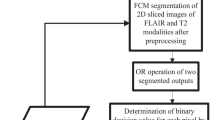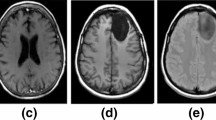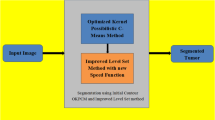Abstract
Brain tumour is a lump of tissue produced by uncontrolled growth of cells in the human brain. Automated and accurate detection of brain tumour is important for robotics based surgery operation. The proposed method enhances the accuracy, sensitivity and specificity of automated brain tumour detection by adopting an accurate two phase method of detection. The method segments the Axial plane slices of Magnetic Resonance image in its first phase. In the second phase, binary decision values representing the presence or absence of tumor cells on each pixel locations are projected into 3D space to obtain the 3D tumor. Contrast Enhanced fuzzy c-means (CEFCM) clustering method is used to segment the 2D tumor regions from MR image slices due to its high accuracy. The decision values obtained from the segmented image for each pixel locations are mapped into 3D space using Pixel based voxel mapping technique (PBVMT). Average accuracy (Dice overlap coefficient) and average sensitivity of detection are measured with respect to the given ground truth of the image of BRATS 2013 dataset. The overall accuracy, sensitivity and specificity of detection are found to be 0.948, 92.14% and 96.97% respectively.












Similar content being viewed by others
References
Abdel-Maksoud E, Elmogy M, Al-Awadi R (2015) Brain tumor segmentation based on a hybrid clustering technique. Egypti Inf J 16(1):71–81
Ahmadvand A, Daliri MR, Zahiri SM (2018) Segmentation of brain MR images using a proper combination of DCS based method with MRF. Multimed Tools Appl 77(7):8001–8018
Anitha V, Murugavalli S (2016) Brain tumour classification using two-tier classifier with adaptive segmentation technique. IET Comput Vis 10(1):9–17
Aruchamy S, Kumar RK, Bhattacharjee P, Sanyal G (2016) Automated skull stripping in brain MR images. In: 2016 3rd International conference on computing for sustainable global development (INDIACom). IEEE, pp 2043–2047
Arulanandam S, Selvarasu S (2018) Adaptive weighted fuzzy region based optimization for brain MR image segmentation. Multimed Tools Appl. https://doi.org/10.1007/s11042-018-6215-y
Aslam A, Khan E, Beg MS (2015) Improved edge detection algorithm for brain tumor segmentation. Proc Comput Sci 58:430–437
Banday SA, Mir AH (2017) Statistical textural feature and deformable model based brain tumor segmentation and volume estimation. Multimed Tools Appl 76(3):3809–3828
Busa S, Vangala NS, Grandhe P, Balaji V (2019) Automatic brain tumor detection using fast fuzzy c-means algorithm. In: Saini H, Sayal R, Govardhan A, Buyya R (eds) Innovations in computer science and engineering. Lecture notes in networks and systems, vol 32. Springer, Singapore. https://doi.org/10.1007/978-981-10-8201-6_28
Chansuparp M, Rodtook A, Rasmequan S, Chinnasarn K (2015) The automated skull stripping of brain magnetic resonance images using the integrated method. In: 2015 8th Biomedical engineering international conference (BMEiCON). IEEE, pp 1–5
Debnath S, Talukdar FA (2019) Brain tumour segmentation using memory based learning method. Multimed Tools Appl 78(16):23689–23706
Gao Y (2020) The application of artificial neural network in watch modeling design with network community media. J Ambient Intell Hum Comput. https://doi.org/10.1007/s12652-020-01689-6
Gonzalez RC, Woods RE (2011) Digital image processing, 3rd edn. Pearson, London
Gordillo N, Montseny E, Sobrevilla P (2013) State of the art survey on MRI brain tumor segmentation. Magn Reson Imaging 31(8):1426–1438
Havaei M, Davy A, Warde-Farley D, Biard A, Courville A, Bengio Y, Larochelle H (2017) Brain tumor segmentation with deep neural networks. Med Image Anal 35:18–31
Hesamian MH, Jia W, He X, Kennedy P (2019) Deep Learning Techniques for Medical Image Segmentation: Achievements and Challenges. J Dig Imaging. https://doi.org/10.1007/s10278-019-00227-x
Jian Z, Qingyuan Z, Liying T (2020) Market revenue prediction and error analysis of products based on fuzzy logic and artificial intelligence algorithms. J Ambient Intell Hum Comput. https://doi.org/10.1007/s12652-019-01650-2
Kaur T, Saini BS, Gupta S (2018) A joint intensity and edge magnitude-based multilevel thresholding algorithm for the automatic segmentation of pathological MR brain images. Neural Comput Appl 30(4):1317–1340
Liu L, Chen S, Zhang F, Wu FX, Pan Y, Wang J (2020) Deep convolutional neural network for automatically segmenting acute ischemic stroke lesion in multi-modality MRI. Neural Comput Appl 32(11):6545–6558
Menze BH, Jakab A, Bauer S, Kalpathy-Cramer J, Farahani K, Kirby J, Lanczi L (2015) The multimodal brain tumor image segmentation benchmark (BRATS). IEEE Trans Med Imaging 34(10):1993–2024
Patel A, Mehta K (2012) 3D modeling and rendering of 2D medical image. In: 2012 International conference on communication systems and network technologies (CSNT). IEEE, pp 149–152
Pereira S, Pinto A, Alves V, Silva CA (2016) Brain tumor segmentation using convolutional neural networks in MRI images. IEEE Trans Med Imaging 35(5):1240–1251
Popovic N, Miljkovic N, Djordjevic O, Sekara TB (2016) Artifact cancellation using median filter moving average filter and fractional derivatives in biomedical signals. In: Proc of the ICFDA, pp 150–161
Ramadas M, Abraham A (2019) Detecting tumours by segmenting MRI images using transformed differential evolution algorithm with Kapur’s thresholding. Neural Comput Appl. https://doi.org/10.1007/s00521-019-04104-0
Reddy GT, Khare N (2018) Heart disease classification system using optimised fuzzy rule based algorithm. Int J Biomed Eng Technol 27(3):183–202
Reddy GT, Reddy MPK, Lakshmanna K, Rajput DS, Kaluri R, Srivastava G (2019) Hybrid genetic algorithm and a fuzzy logic classifier for heart disease diagnosis. Evol Intel. https://doi.org/10.1007/s12065-019-00327-1
Roslan R, Jamil N, Mahmud R (2010) Skull stripping of MRI brain images using mathematical morphology. In: 2010 IEEE EMBS conference on biomedical engineering and sciences (IECBES). IEEE, pp 26–31
Roy S, Maji P (2015) A simple skull stripping algorithm for brain MRI. In: 2015 8th International conference on advances in pattern recognition (ICAPR). IEEE, pp 1–6
Seetha J, Raja SS (2018) Brain tumor classification using convolutional neural networks. Biomed Pharmacol J 11(3):1457
ShanmugaPriya S, Valarmathi A (2018) Efficient fuzzy c-means based multilevel image segmentation for brain tumor detection in MR images. Des Autom Embed Syst 22(1–2):81–93
Shanthi KJ, Kumar MS (2007) Skull stripping and automatic segmentation of brain MRI using seed growth and threshold techniques. In: 2007 International conference on intelligent and advanced system. IEEE, pp 422–426
Singh N, Das S, Veeramuthu A (2017) An efficient combined approach for medical brain tumour segmentation. In: 2017 International conference on communication and signal processing (ICCSP). IEEE, pp 1325–1329
Soltaninejad M, Yang G, Lambrou T, Allinson N, Jones TL, Barrick TR, Ye X (2017) Automated brain tumour detection and segmentation using superpixel-based extremely randomized trees in FLAIR MRI. Int J Comput Assist Radiol Surg 12(2):183–203
Srinivasan A, Sadagopan S (2020) Rough fuzzy region based bounded support fuzzy C-means clustering for brain MR image segmentation. J Ambient Intell Hum Comput. https://doi.org/10.1007/s12652-019-01672-w
Subudhi A, Jena J, Sabut S (2016) Extraction of brain from MRI images by skull stripping using histogram partitioning with maximum entropy divergence. In: 2016 International conference on communication and signal processing (ICCSP). IEEE, pp 0931–0935
Tian Z, Dey N, Ashour AS, McCauley P, Shi F (2018) Morphological segmenting and neighborhood pixel-based locality preserving projection on brain fMRI dataset for semantic feature extraction: an affective computing study. Neural Comput Appl 30(12):3733–3748
Vrbaški M, Doroslovački R, Kupusinac A, Stokić E, Ivetić D (2019) Lipid profile prediction based on artificial neural networks. J Ambient Intell Hum Comput. https://doi.org/10.1007/s12652-019-01374-3
Yunjie C, Jianwei Z, Shunfeng W (2009) A new fast brain skull stripping method, biomedical engineering and informatics. In: Proc. 2nd International conference on biomedical engineering and informatics, BMEI09. Tianjin
Zhou X (2020) The usage of artificial intelligence in the commodity house price evaluation model. J Ambient Intell Hum Comput. https://doi.org/10.1007/s12652-019-01616-4
Zhao W, Xie M, Gao J, Li T (2010) A modified skull-stripping method based on morphological processing. In: Second international conference on computer modeling and simulation, 2010. ICCMS'10, vol 1. IEEE, pp 159–163
Acknowledgements
The authors would like to acknowledge Speech and Signal Processing Laboratory, ECE Department, National Institute of Technology Silchar, Assam, India for providing support and necessary facilities for carrying out the research work.
Author information
Authors and Affiliations
Corresponding author
Ethics declarations
Conflict of interest
The authors declare that there is no conflict of interests regarding the publication of this paper.
Additional information
Publisher's Note
Springer Nature remains neutral with regard to jurisdictional claims in published maps and institutional affiliations.
Rights and permissions
About this article
Cite this article
Debnath, S., Talukdar, F.A. & Islam, M. Combination of contrast enhanced fuzzy c-means (CEFCM) clustering and pixel based voxel mapping technique (PBVMT) for three dimensional brain tumour detection. J Ambient Intell Human Comput 12, 2421–2433 (2021). https://doi.org/10.1007/s12652-020-02366-4
Received:
Accepted:
Published:
Issue Date:
DOI: https://doi.org/10.1007/s12652-020-02366-4




